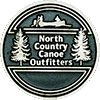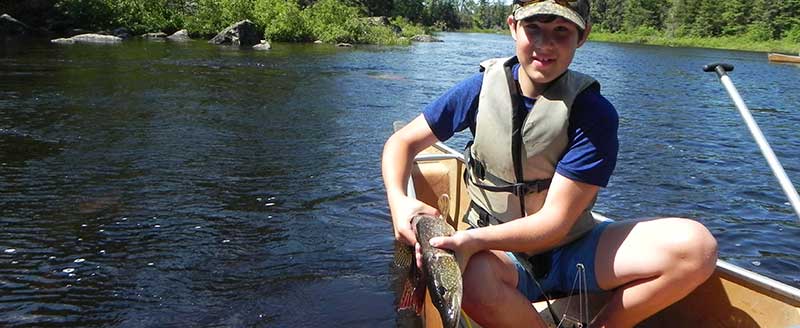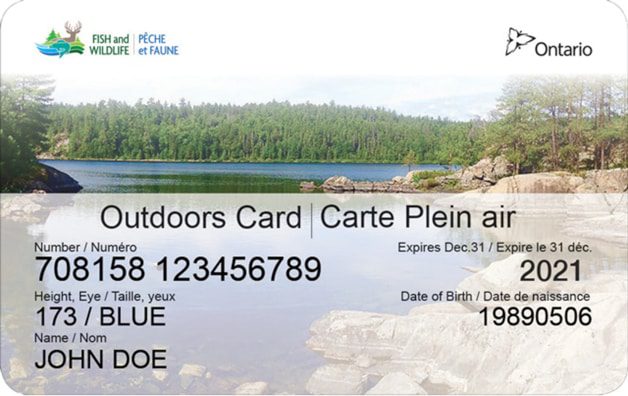Fishing Tips

Boundary Waters fishing tips are worth about a dime per dozen. Lucky for most of us, ’cause there seems to be a tip for every fishin’ hole, in every weather condition, for every type of game fish in America! Why does it have to be so confusing? It doesn’t! “Tips” are just that – just something to try when your way isn’t working. So read through this list, remember a third of them, and try two or three. Who knows … one of them might just work!
Getting ready to go
- Just as there are two different areas, the Boundary Waters and Quetico Park, each requires its own license. If you are only going to fish on one side of the border, Minnesota or Ontario, only the appropriate one license is necessary.
- A Minnesota fishing license is required for the Boundary Waters Canoe area (US side. In Minnesota, the age where a license is required is 16.
Licenses may be purchased here at North Country’s base for BWCA trips. The license which most of our non-Minnesota Resident clients purchase is the seven calendar day license, and costs $37.00. We also offer a 72-clock hour license, normally spanning over four calendar days. We can start the license on any day and time you select. It then runs for 72 hours. If the license started at 10:30 AM on the 9th, it would expire at 10:30 AM on the 12th. This is best for three- or four-day trips, and costs $25. A 24-clock hour license is also available, and works the same way spanning two calendar days. The cost is $9.50. We also offer Seasonal, Husband/Wife Married Couple, and Family Licenses.
- Your Social Security Number is required to purchase any fishing license in Minnesota. This is a state law; no number, no license. The only exception is for a foreign citizen; the country code and passport number are used instead.
- Minnesota Licenses may be purchased here at North Country’s base for BWCA trips.
-
An Ontario Angling Permit is required for Quetico Provincial Park (Canada). In Ontario, the age where a license is required is 18. To purchase an non-Canadian Resident Ontario Angling Permit, one must first buy an Ontario Outdoors Card (CN$9.68). After getting this number, the permit amy then be purchased. The Eight-day Conservation Fishing License Tag is the one we recommend (CN$29.40). Both the Outdoor Card and the Angling Permit must be in your possession to fish in Ontario. Both may be secured on line at the Ontario Ministry.
- We highly recommend getting your Ontario Card and E-License prior to your arrival. This will save a huge amount of time at the border. (We cannot issue these here at our base.) They should be secured on line from the Ontario Ministry Of Natural Resources. Be very careful to use the correct starting date: the day you will actually start fishing in Ontario.
- Protect your eyes – God only gave you one pair of eyes. Protect them on the water. Invest in a good pair of polarized sunglasses. They will not only help protect your eyes, but will also give you better visual penetration into the water.
- Keep your mosquito repellent and plastic worms out of your tackle box or at least in a special separate compartment. Both of these items contain lacquer solvent and when in contact with any metal, plastic, or wood lure, it has a tendency to soften the paint. The paint will never harden again.
- Keep hooks sharp – There’s no excuse losing a fish because of a dull hook. A small stone or file should be used to keep hooks needle sharp.
- Learn to tie good knots – Many fish are lost to faulty knots. Usually the box your fresh line came in (above !) Will have an instruction sheet. Practice until you are sure they will hold.
The Area
- For the most part, the lakes in the BWCA are darker than Quetico Park. The water color comes from tannin, the same thing that makes tea brown (it has nothing to do with iron in the water). Be sure not to confuse “dark” with “muddy”. Contrast is important when selecting lures: too much difference between a lure and its’ surroundings and a fish will figure something is wrong with this picture. In general, use darker lures in darker water, and lighter lures in water that is more “tap-water” clear.
- The rule stating that everything that goes up must come down does not apply to fishing lures caught in trees. Avoid long cast toward the waters edge when overhanging trees are a factor.
- In rivers, most game fish are best attracted to your lure when it is presented in a down stream manner duplicating natural food presentation.
In General
- Be versatile. Don’t get into a rut or hung up on one technique. What “works at home on largemouth” isn’t the way you fish walleye in the north country. The locations and lure recommendations we make are based on information as fresh as we can possibly have. In many cases, it is what was producing on those lakes just the last day or so. We want you to catch fish!
- Don’t fish any lure in one spot more than 10 casts. If it hasn’t worked by then, change, and let the fish tell you what they want.
- Proper canoe positioning can play a large role in success or failure of wilderness fishing in the north country. The distance between you and the fish is very important. If you’re too close, you will spook the fish more often than catch them. If you are too far, your accuracy in placing the lure can be hampered.
- Don’t be too eager, beaver – When top water fishing, do not set the hook until you actually feel the fish on the lure. Don’t jerk on sight or sound. Just keep working the lure toward you.
- Be patient! Fish don’t always hit a lure just because it’s there. They go thru cycles and have schedules like people. If you know you are in a good fish-producing area, patience can pay off.
- Be quiet! Sound travels through the water much better than through air. Avoid all unnecessary noise in the canoe.
- Catch and release – Fish love to hold on structures and irregular features under water. Carefully release, immediately and unharmed, any fish you do not intend to eat. Preservation of our fishing resources is necessary even here in the north country.
- Stop and smell the waterlilies – Whether you catch anything or not, look around you – and enjoy it for what it is – the only lakeland wilderness in the world! As Ely sportswriter Bob Cary said, “The fishing in Ely is always great. The catching isn’t always great, but the FISHING is always great!”
Fishing the Boundary Waters
The vast system of Boundary Waters / Quetico lakes cover approximately 1,500 square miles. Healthy fish habitat provides sustainable benefits to sport, commercial and domestic users throughout the wilderness area. Anglers from around the world come to the North Country each year to experience the trill of freshwater fishing. People of all ages challenge themselves to pursue the elusive record size fish. Catching trophy northern pike, walleye, smallmouth bass, lake trout and brook trout, crappie and other fish is not uncommon. Our pristine lakes offer plenty of opportunity for catching big fish.
You can test your skills, savor a shore lunch while enjoying top notch equipment, safe canoeing equipment and our excellent planning and trip routing services. North Country preserves our fishing traditions through conservation practices and the support of our fishing customers from around the world. Using fishing resources with care and respect has helped to guarantee world-class angling adventures for years to come.
Come and experience some of the North Country’s best freshwater fishing and once you have had a full day of enjoyment in the wilderness you may want to sample the great taste of our special recipe fishing breading mix.
See specific pages about: Walleye, Northern Pike, Smallmouth Bass, Trout, and Panfish




